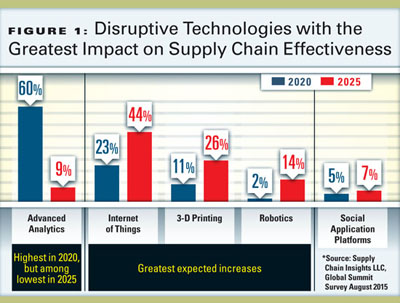Making the Digital Pivot
Today, one in nine companies are stuck. They are unable to drive improvement in the supply chain metrics that matter (inventory turns, operating margin, and Return on Invested Capital).
One in three companies recognize that there is a problem, but they do not know how to fix it. While many companies are spending 1.7 percent of revenue on traditional software systems, the dilemma is that there is nowhere to put digital data. I believe that the answer lies in the redesign of processes to be outside in and digital. In this process, many of the applications being implemented today, will become legacy.
The digitization of data offers promise. Digital data is structured and unstructured. In the redesign of new processes, companies will need to embrace a variety of data. It moves quickly and is more transferrable to mobile devices and machines. Data velocity and variety are both opportunities and obstacles in digital supply chain redesign.
Why digital? There are five primary drivers of the digital outside-in processes. While e-commerce was the driver of supply chain transformation in the last decade, digital transformation is the driver in the race for supply chain 2025. Here are five facts to ponder:
At a recent conference, when we asked companies to plot their path to build digital outside-in processes, we received the response in Figure 1. In the first phase of building digital processes it will be about the adoption of analytics. Early adopters today are evaluating prescriptive and cognitive analytics to improve agility, and the building of new systems to better use data in existing systems through the adoption of in-memory visualization is of strong interest. The focus will then shift to confluence of digital techniques—Internet of Things, 3-D printing, robotics and manless vehicles and the power of the crowd. It will not be one; instead it will be the combination of these techniques that will define digital breakthroughs.

One in three companies recognize that there is a problem, but they do not know how to fix it. While many companies are spending 1.7 percent of revenue on traditional software systems, the dilemma is that there is nowhere to put digital data. I believe that the answer lies in the redesign of processes to be outside in and digital. In this process, many of the applications being implemented today, will become legacy.
The digitization of data offers promise. Digital data is structured and unstructured. In the redesign of new processes, companies will need to embrace a variety of data. It moves quickly and is more transferrable to mobile devices and machines. Data velocity and variety are both opportunities and obstacles in digital supply chain redesign.
Why digital? There are five primary drivers of the digital outside-in processes. While e-commerce was the driver of supply chain transformation in the last decade, digital transformation is the driver in the race for supply chain 2025. Here are five facts to ponder:
- Companies want adaptive systems. Today’s supply chain processes respond. They do not sense. Because they cannot sense, they do not adapt. Global markets are both concentrated and dispersed. They are dynamic. Without sensing, and market-driven, outside-in processes, there is continued loss of opportunity. The organization is out of step with the market.
- The supply chain is a non-linear, complex adaptive system that we are modeling using linear optimization. The first and second generations of supply chain technologies were built on linear optimization. Based on technology capabilities at the time, it was all that we could do.
- Customer data has never been more available. However, there is a gap in our ability to use it. With the evolution of social, mobile and web-based technologies, customer data has never been more available. The irony is that we are unable to use it. The use of unstructured and semi-structured customer data requires new techniques and processes.
- Digital data moves quickly at the cadence of business. Enterprise systems move slowly at the speed of transactions. Our enterprise solutions are slow and inflexible. They cannot move at the cadence of business. The world has become digital. Supply chains are out of step with digital world.
- Inside out versus outside in. The traditional supply chain depends on orders and shipments. Both signals have data latency (out of sync with the market) and accelerate the bullwhip effect. MRP and DRP logic uses order and shipment data permeating the bullwhip effect. The movement to outside-in processes has the potential to reduce waste and prevent the distortion of signals between nodes in a value network.
At a recent conference, when we asked companies to plot their path to build digital outside-in processes, we received the response in Figure 1. In the first phase of building digital processes it will be about the adoption of analytics. Early adopters today are evaluating prescriptive and cognitive analytics to improve agility, and the building of new systems to better use data in existing systems through the adoption of in-memory visualization is of strong interest. The focus will then shift to confluence of digital techniques—Internet of Things, 3-D printing, robotics and manless vehicles and the power of the crowd. It will not be one; instead it will be the combination of these techniques that will define digital breakthroughs.


